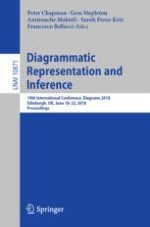2018 | Book
Diagrammatic Representation and Inference
10th International Conference, Diagrams 2018, Edinburgh, UK, June 18-22, 2018, Proceedings
Editors: Peter Chapman, Dr. Gem Stapleton, Amirouche Moktefi, Sarah Perez-Kriz, Francesco Bellucci
Publisher: Springer International Publishing
Book Series : Lecture Notes in Computer Science
